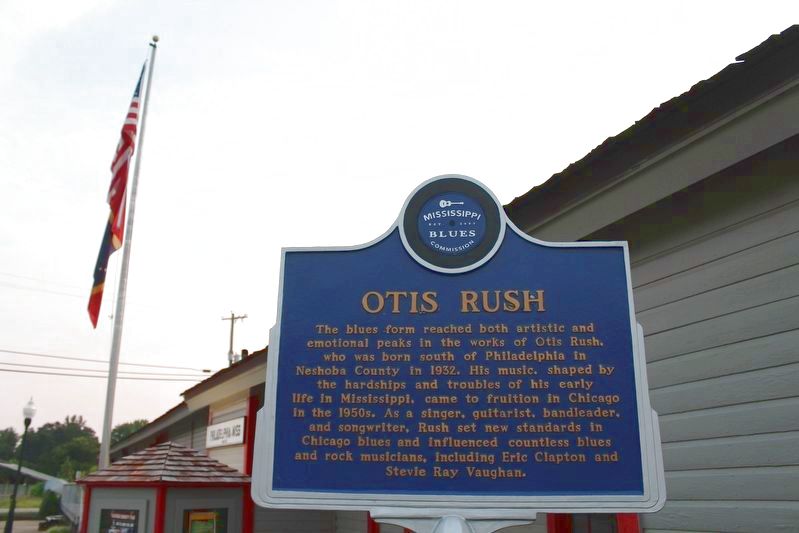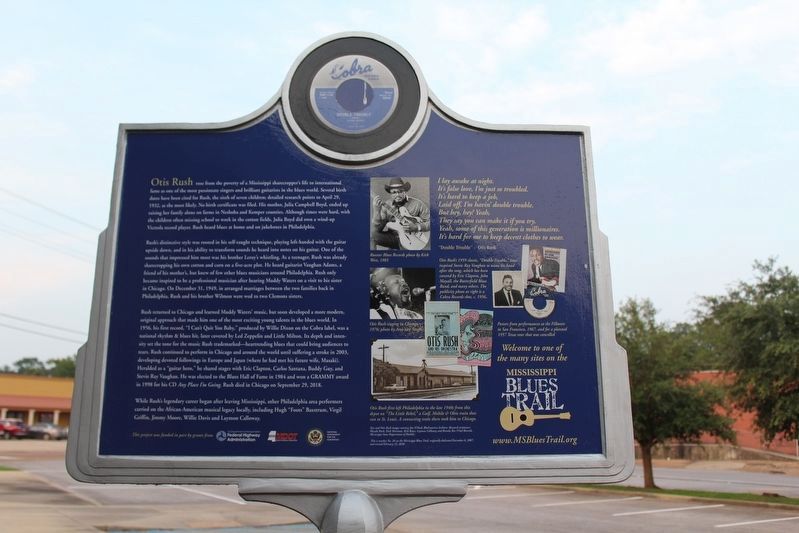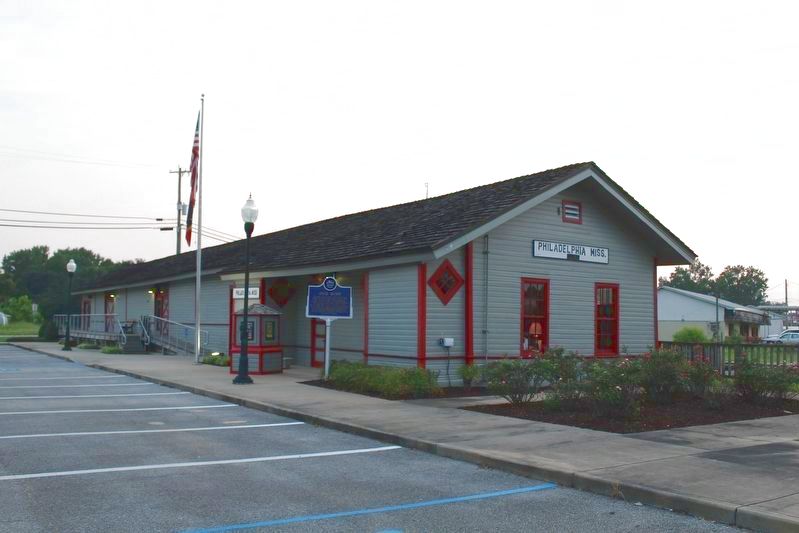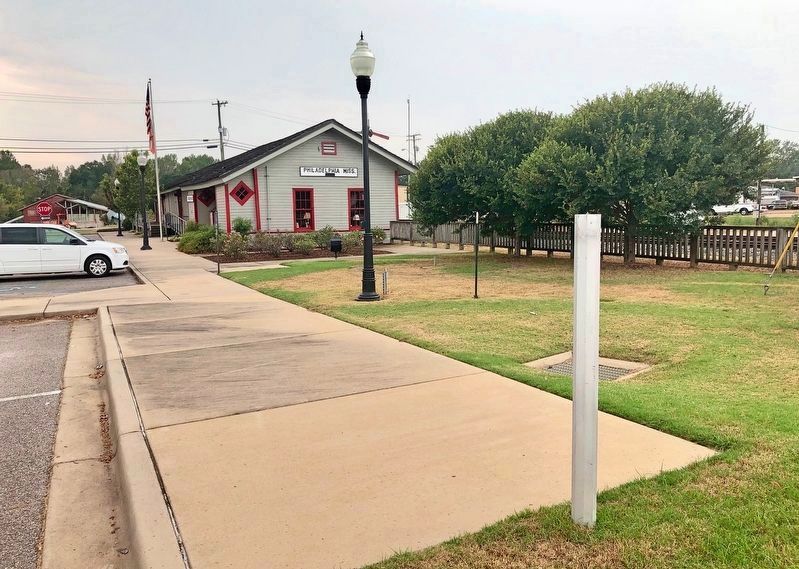Philadelphia in Neshoba County, Mississippi — The American South (East South Central)
Otis Rush
[Reverse]
Otis Rush rose from the poverty of a Mississippi sharecropper’s life to international fame as one of the most passionate singers and brilliant guitarists in the blues world. Rush, the sixth of seven children, was born in 1935, according to family sources, although biographies often give his birth date as 1934. His mother, Julia Campbell Boyd, ended up raising her family alone on farms in Neshoba and Kemper counties. During the throes of the Great Depression in a segregated society, although times were hard, with the children often missing school to work in the cotton fields, Julia Boyd did own a wind-up Victrola record player. Rush heard blues records at home and on jukeboxes in Philadelphia when his mother would bring him to town. He began playing harmonica, and also sang in a church choir.
When his oldest brother, Leroy Boyd, was away from home, Otis started secretly playing Leroy’s guitar. With no musical training, he devised his own unorthodox method, playing left-handed with the guitar upside down. Rush’s distinctive style was rooted in his self-taught technique and his ability to transform sounds he heard into notes on his guitar. One sound he recalled from his childhood was Leroy's whistling.
As a young teen, Rush was already married, sharecropping cotton and corn on a five-acre plot. On Otis Lewis’s farm, Rush heard guitarist Vaughan Adams, a friend of his mother's, but there were few other blues musicians around Philadelphia. Rush only became inspired to be a professional musician after visiting his sister in Chicago. She took him to a Muddy Waters performance, and, as Rush recalled, “I flipped out, man. I said, ‘Damn. This is for me.’”
Rush moved to Chicago and learned Waters’s music, but soon developed a more modern, original approach that made him one of the most exciting young talents in the blues world. In 1956, his first record, “I Can’t Quit You Baby,” produced by Willie Dixon on the Cobra label, was a national rhythm & blues hit, later covered by Led Zeppelin and Little Milton Campbell. Its depth and intensity set the tone for the music Rush trademarked–heartrending blues that sometimes brought audiences to tears. Rush continued to perform in Chicago and around the world, developing devoted followings in Europe and Japan. Heralded as a “guitar hero,” he shared stages with Eric Clapton, Carlos Santana, Buddy Guy, and Stevie Ray Vaughan. He was elected to the Blues Hall of Fame in 1984, and won a GRAMMY® award in 1998 for his CD Any Place I’m Going.
Erected 2007 by the Mississippi Blues Commission. (Marker Number 26.)
Topics and series. This historical marker is listed in these topic lists: African Americans • Arts, Letters, Music • Entertainment. In addition, it is included in the Grammy Award Winners, and the Mississippi Blues Trail series lists. A significant historical year for this entry is 1935.
Location. 32° 46.291′ N, 89° 7.021′ W. Marker is in Philadelphia, Mississippi, in Neshoba County. Marker can be reached from West Beacon Street (Mississippi Route 21) west of Front Ave, on the left when traveling west. Located at the Old Depot (Welcome Center). Touch for map. Marker is at or near this postal address: 256 W Beacon St, Philadelphia MS 39350, United States of America. Touch for directions.
Other nearby markers. At least 8 other markers are within walking distance of this marker. Marty Stuart (approx. 0.4 miles away); Marty Gamblin (approx. 0.4 miles away); Neshoba County Confederate Monument (approx. 0.4 miles away); Old Neshoba County Jail (approx. 0.4 miles away); Booker T. Washington School (approx. half a mile away); Adam Monroe Byrd (approx. 0.6 miles away); Grierson's Raid 1863 (approx. 0.6 miles away); Philadelphia Historic District (approx. 0.6 miles away). Touch for a list and map of all markers in Philadelphia.
More about this marker. According to the nearby Welcome Center inside the train depot, this marker was taken down to be refurbished.
UPDATE: In Dec. 2020 the refurbished marker was re-installed but moved closer to the nearby Welcome Center.
Also see . . .
1. Wikipedia entry on Otis Rush w/photo. (Submitted on October 10, 2019, by Mark Hilton of Montgomery, Alabama.)
2. Marker dedication. (Submitted on October 11, 2019, by Tim Fillmon of Webster, Florida.)
Credits. This page was last revised on July 31, 2023. It was originally submitted on October 10, 2019, by Mark Hilton of Montgomery, Alabama. This page has been viewed 293 times since then and 36 times this year. Photos: 1, 2, 3. submitted on August 6, 2021, by Tom Bosse of Jefferson City, Tennessee. 4. submitted on October 10, 2019, by Mark Hilton of Montgomery, Alabama.



